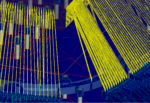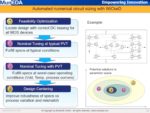Current technology news is filled with talk of many edge applications moving processing from the cloud to the edge. One of the presentations at the recently concluded Linley Group Fall Processor Conference was about AI moving from the cloud to the edge. Rightly so, there were several sessions dedicated to discussing AI and edge… Read More
Electronic Design Automation
Siemens EDA will be returning to DAC this year as a Platinum Sponsor.
The 38th Design Automation Conference is next week and this one is for the record books. Having been virtual the last two years, next week we will meet live once again. I think we may have all taken for granted the value of live events but now we know how important they are on both a professional and human level, absolutely.
“The… Read More
Big Data Helps Boost PDN Sign Off Coverage
The nearly unavoidable truth about dynamic voltage drop (DVD) signoff for power distribution networks (PDN) is that the quality of results depends on the quality and quantity of the vectors used to activate the circuit switching. As SOCs grow larger and are implemented on smaller nodes, the challenges of sufficient coverage … Read More
Empyrean Technology‘s Complete Design Solution for PMIC
Power management integrated circuits (PMICs) are integrated circuits for power management. Driven by the strong demand in consumer electronics, IoT, and the automobile industry, the design for PMIC is getting more challenging in terms of integration, reliability and efficiency. The design methodology needs to be updated… Read More
WEBINAR: Using Design Porting as a Method to Access Foundry Capacity
There have always been good reasons to port designs to new foundries or processes. These reasons have included reusing IP in new projects, moving an entire design to a smaller node to improve PPA, or second sourcing manufacturing. While there can be many potential business motivations for any of the above, in today’s environment… Read More
Bonds, Wire-bonds: No Time to Mesh Mesh It All with Phi Plus
Automatic adaptive meshing in HFSS is a critical component of its advanced simulation process. Guided by Maxwell’s Equations, it efficiently refines the mesh to accurately capture both the geometric and electromagnetic detail of a design. The end result is a process that guarantees accurate and reliable simulation results… Read More
Learning-Based Power Modeling. Innovation in Verification
Learning-Based Power Modeling. Innovation in Verification
Is it possible to automatically generate abstract power models for complex IP which can both run fast and preserve high estimation accuracy? Paul Cunningham (GM, Verification at Cadence), Raúl Camposano (Silicon Catalyst, entrepreneur, former Synopsys CTO) and… Read More
Machine Learning Applied to IP Validation, Running on AWS Graviton2
I recall meeting with Solido at DAC back in 2009, learning about their Variation Designer tool that allowed circuit designers to quickly find out how their designs performed under the effects of process variation, in effect finding the true corners of the process. Under the hood the Solido tool was using Machine Learning (ML) techniques… Read More
Numerical Sizing and Tuning Shortens Analog Design Cycles
By any measure analog circuit design is a difficult and complex process. This point is driven home in a recent webinar by MunEDA. Michael Pronath, VP Products and Solutions at MunEDA, lays out why, even with the assistance of simulators, analog circuit sizing and tuning can consume weeks of time in what can potentially be a non-convergent… Read More
Synopsys Expands into Silicon Lifecycle Management
I spoke with Steve Pateras of Synopsys last week to better understand what was happening with their Silicon Lifecycle Management vision, and I was reminded of a Forbes article from last year: Never Heard of Silicon Lifecycle Management? Join the Club. At least two major EDA vendors are now using the relatively new acronym SLM, and… Read More










cHBM for AI: Capabilities, Challenges, and Opportunities